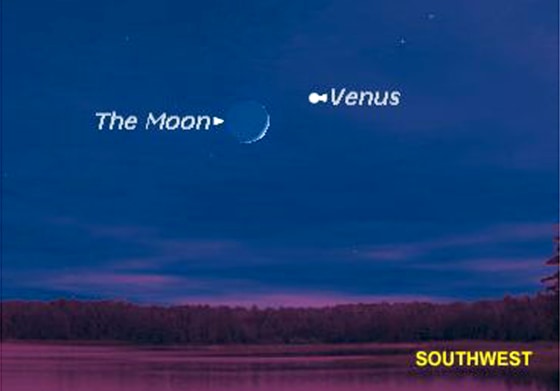The planet Venus continues to shine like a silvery-white lantern in the southwestern sky for about 2½ -hours after sundown. On Christmas night, Dec. 25, a lovely crescent Moon will join the bright planet at twilight, making for an eye-catching pair of celestial ornaments.
Although by the standards of most Venus-Moon pairings the two objects will not be particularly close together in our sky, they still will likely draw attention, even for those who normally might not look up. Venus will appear to hover well to the right and somewhat above the Moon.
If it is cloudy on Christmas night, do not despair. There will be five more opportunities to see the crescent Moon and Venus in our evening sky during the first half of 2004.
The future dates to note: Jan. 24, Feb. 23, March 24, April 22 and May 20.
This vision is sometimes called "the old Moon in the young moon’s arms." Leonardo da Vinci (1452-1519) was the first to recognize it as earthshine. That faint bluish-gray light is sunlight reflected from the Earth to the Moon and back again.
Another way to explain this is to imagine yourself standing on the surface of the Moon on Christmas night. Looking up into the sky, you would see a nearly full Earth. In fact, the phases of the Earth are the exact opposite of those of the Moon as seen from the Earth. A new Moon on Earth, for example, translates into a full Earth as seen from the Moon. This effect is known as "complimentary phases."
So, if you were are standing on that part of the Moon not in sunlight on Christmas night, your only light source would come from that nearly full (93 percent illuminated) Earth.
Now if you’ve ever been outside around the time of a full Moon, you’ve probably noticed how it can light up the surrounding landscape. Imagine seeing the
You'll also want to note Venus' brilliance if you step out. Besides the Moon, Venus is the dominant celestial object in the evening.
One of these mysteries concerned the movement of the planets; they believed the planets indicated the actions of the gods and that what the gods did was important to the affairs of man. Such primitive religions were the origins of today’s astrology—not to be confused with astronomy—and they were also the ancestors of astronomy.
The likelihood that the Magi would have confused a familiar planet with a new star seems remote. However, perhaps they witnessed a planetary grouping of particular beauty; an exceptionally close conjunction of two planets or a massing of several planets creating an eye-catching geometric figure in the sky.
New knowledge of the old astrological beliefs and modern computer-based planetary tables may yet shed new light on this age-old question.
